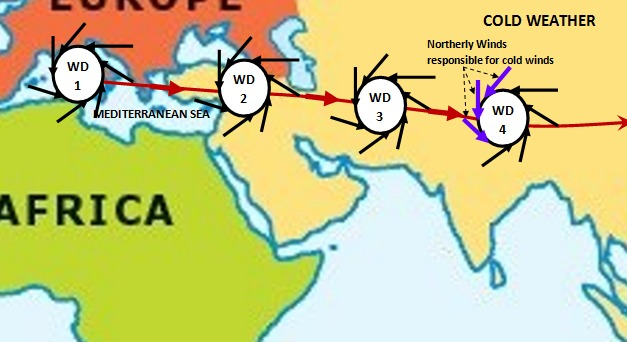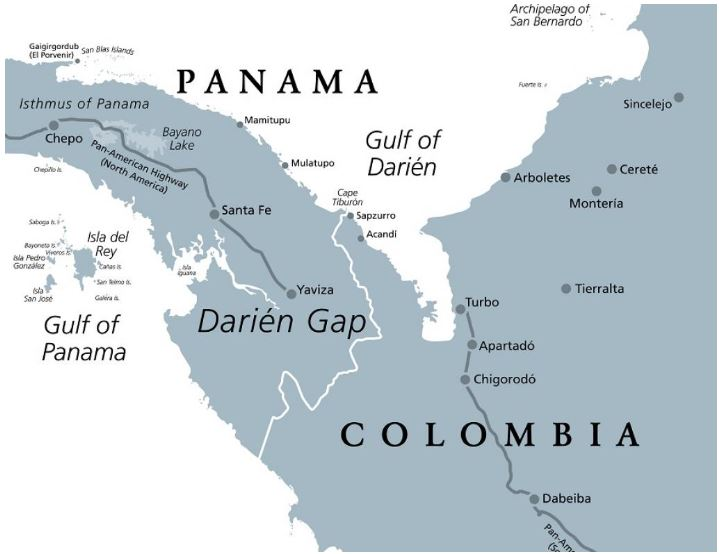Western Disturbance
Syllabus: GS1/ Geography
In Context
- The India Meteorological Department (IMD) has reported a sharp temperature drop across North India due to an active western disturbance positioned over North Pakistan.
What is Western Disturbance (WD)?
- It is an extra-tropical storm that originates in the Mediterranean region.
- The disturbance travels from the “western” to the eastern direction and gradually travels across the middle-east from Iran, Afghanistan and Pakistan to enter the Indian subcontinent.
- Disturbance means an area of “disturbed” or reduced air pressure.
- Equilibrium exists in nature due to which the air in a region tries to normalize its pressure.
- Disturbance means an area of “disturbed” or reduced air pressure.
- In the term “extra-tropical storm”, the storm refers to low pressure.
- “Extra-tropical” means outside the tropics (as WD originates outside the tropical region).
- The disturbance travels from the “western” to the eastern direction and gradually travels across the middle-east from Iran, Afghanistan and Pakistan to enter the Indian subcontinent.

Image Courtesy: Weatherview
Impacts
- It brings rainfall, snowfall, and fog to northern India.
- WD is important for the agriculture of the Rabi crop in the Northern subcontinent.
- The WD is not always the harbinger of good weather and sometimes, they can cause extreme weather events like floods, flash floods, landslides, dust storms, hail storms and cold waves killing people, destroying infrastructure and impacting livelihoods.
| Indian Meteorological Department – Established in 1875. – The India Meteorological Department is an agency of the Ministry of Earth Sciences of the Government of India. – It is the principal agency responsible for meteorological observations, weather forecasting and seismology. |
Source: PIB
Darien Gap
Syllabus: GS1/World Geography
Context
- Darien Gap was in the news for being a major route for the illegal migration to the US.
Darien Gap
- The Darien Gap is a dense, swampy rainforest spanning approximately 97 km (60 miles) between northern Colombia in South America and southern Panama in North America.
- Environment: The terrain is characterized by muddy trails, wetlands, and steep mountains, making it one of the most inhospitable and dangerous regions in the world.
- Concerns: The area is controlled by criminal gangs and armed groups, further increasing the dangers for those attempting to cross it.

Source: IE
Power to Grant Furloughs
Syllabus :GS 2/Governance
In News
Convicts of the Hashimpura massacre have moved the Delhi High Court against a Delhi prison rule about furloughs.
- The rule vests power to grant furlough with the court where the appeal against conviction is pending.
About Furloughs and How is it different from Parole?
- Both furlough and parole are conditional releases, but differ in their implications.
- Furlough allows convicts to be temporarily released without suspending their sentence, meaning the time spent on furlough counts toward the sentence.
- It is typically granted to long-term prisoners for reasons like preventing isolation and fostering social ties.
- Parole suspends a convict’s sentence temporarily and is usually granted for specific reasons like illness or agricultural needs.
- Delhi Prison Rules 2018: The challenged rule (Note 2 of Rule 1224) states that furlough cannot be granted if an appeal is pending before the High Court or Supreme Court, and the convict must seek the court’s direction.
- This provision is under scrutiny as it may violate constitutional rights, including Articles 14 (equality) and 21 (right to life and liberty), and may contradict the reformative approach to punishment.
- High Court’s Interpretation: A single judge of the Delhi HC has interpreted that the rule applies to both the Delhi HC and SC.
- Now, a division bench is examining the rule’s constitutional validity and whether it unfairly denies furlough despite good behavior.
| Do you know? – The case of KM Nanavati in 1960 set a precedent where the SC ruled that only the court, not the governor, can suspend a sentence during the pendency of an appeal. – Some states deny furlough during an appeal, with NALSA highlighting that this is because convicts can request relief from the court. 1. Several states are part of ongoing litigation regarding this practice. |
Source :IE
Brucellosis
Syllabus: GS 2/Health
In News
- An eight-year-old girl from Kerala recently died after being treated for brucellosis for two months.
About Brucellosis
- It is a bacterial zoonotic disease caused by Brucella species, mainly affecting livestock like cattle, goats, sheep, and swine
- Transmission : It is transmitted to humans through contact with infected animals, consumption of unpasteurized milk or cheese, or inhalation of airborne agents.
- The disease is common in endemic areas and can have serious public health implications.
- Most cases result from consuming raw milk or cheese, especially from sheep and goats.
- Symptoms of brucellosis include fever, weakness, weight loss, and general discomfort.
- In many cases, symptoms are mild, which can delay diagnosis. The incubation period varies from one week to two months, but usually lasts 2-4 weeks.
- Risk Groups: Farmers, butchers, veterinarians, and laboratory workers are at higher risk due to direct contact with infected animals, blood, or bodily fluids.
- Prevention and Control: The key strategy is to eliminate infection in animals, including vaccination and culling.
- Pasteurization of milk and raising awareness about food safety help reduce human infection.
- Brucellosis is treated with doxycycline combined with streptomycin or rifampicin, typically for 45 days.
Source :TH
Chandrayaan-4 Set to Launch in 2027
Syllabus: GS3/ Science and Technology
Context
- India will launch the Chandrayaan-4 mission to bring back samples of moon rocks to the Earth in 2027.
About
- Chandrayaan-1: It was launched in 2008 and was India’s first lunar mission. It made India the fifth country to reach the Moon.
- The mission’s most significant discovery was the presence of water molecules on the lunar surface, a finding confirmed by NASA.
- Chandrayaan-2: It was launched in 2019 with an orbiter, a lander (Vikram), and a rover (Pragyan).
- The mission aimed to achieve a soft landing on the lunar surface, but ISRO lost contact with the lander just before touchdown, resulting in a crash landing.
- Despite this setback, the orbiter continued functioning and provided crucial data on the Moon’s surface and atmosphere.
- Chandrayaan-3, a follow-on mission to Chandrayaan-2, successfully achieved a soft landing on the Moon’s south pole in 2023.
- Lander payloads: Chandra’s Surface Thermophysical Experiment (ChaSTE) to measure the thermal conductivity and temperature; Instrument for Lunar Seismic Activity (ILSA) for measuring the seismicity around the landing site etc.
- Rover payloads: Alpha Particle X-ray Spectrometer (APXS) and Laser Induced Breakdown Spectroscope (LIBS) for deriving the elemental composition in the vicinity of landing site.
Source: TH
Pinaka Multiple Rocket Launch Systems (MRLS)
Syllabus: GS 3/Defence
In News
- The Union Defence Ministry signed contracts worth ₹10,147 crore for ammunition to enhance the Army’s Pinaka Multiple Rocket Launch Systems (MRLS).
About contracts
- The contracts, with Economic Explosives Limited (EEL) and Munitions India Limited (MIL), involve procuring Area Denial Munition (ADM) Type-1 and High Explosive Pre-Fragmented (HEPF)-Mk-1 rockets, respectively.
- These advanced munitions will improve the Pinaka’s range and firepower.
About Pinaka
- The Pinaka rocket system has been developed by Armament Research and Development Establishment, Pune supported by High Energy Materials Research Laboratory, another Pune-based laboratory of DRDO.
- The Pinaka Mk1 has a range of 38 km and it can fire a variety of ammunition.
- The upgraded Pinaka system, which is becoming the Army’s primary long-range artillery, has already completed successful flight tests of guided rockets with a 75 km range, with plans to extend the range to 120 km and 300 km.
- The Pinaka MLRS can fire 72 rockets in 44 seconds, with four regiments in service and six more ordered.
- Armenia became the first export customer for the indigenously developed Pinaka with interest expressed by several countries in the system.
- The Indian Army has four Pinaka regiments in service and six more are on order.
Source :TH
Stryker Infantry Combat Vehicle
Syllabus: GS3/ Defence
In News
- India and the United States continue to deepen their defence cooperation, with the Stryker Infantry Combat Vehicle (ICV) deal emerging as a key development.
What is the Stryker?
- The Stryker is a highly mobile, eight-wheeled armoured infantry combat vehicle developed by General Dynamics Land Systems (GDLS) in the U.S. and Canada.
- It is designed for rapid deployment, high-altitude warfare, and urban combat scenarios, making it a crucial asset for modern battlefields.
Features of Stryker ICV
- Protection and Survivability:
- Double V-Hull Design: Improves blast resistance against landmines and IEDs.
- Composite Armour with Ceramic Tiles: Provides enhanced ballistic protection from small arms fire and shrapnel.
- Firepower and Combat Capabilities:
- 30 mm autocannon (enhanced firepower for armoured threats).
- Optional 105 mm Mobile Gun System (MGS) for anti-tank capabilities.
- Javelin Anti-Tank Guided Missile (ATGM) compatibility (future upgrades may replace outdated versions).
- Mobility and Deployment:
- Top Speed: 100 km/h.
- Range: 483 km on a single refuel.
- All-Terrain Capability: Performs well in desert, jungle, and high-altitude terrains.
Significance for India
- Improves mobility and protection of Indian troops in harsh Himalayan terrains.
- Strategic deployment in Ladakh and Arunachal Pradesh strengthens India’s position against Chinese border threats.
- The Make in India initiative will be supported through co-production with Bharat Earth Movers Limited (BEML).
- Collaboration will likely involve technology transfer, reducing India’s reliance on foreign defence suppliers.
India-U.S. Defence Collaboration
- Strengthening Bilateral Defence Ties
- Builds on previous India-U.S. defence agreements, including:
- General Electric (GE) F414 jet engine technology transfer.
- MH-60R Seahawk helicopters for the Indian Navy.
- P-8I Poseidon surveillance aircraft for maritime security.
- Predator MQ-9B drones for reconnaissance and strike missions.
- Reinforces India’s role as a key strategic partner in the Indo-Pacific.
- Aligns with QUAD (India, U.S., Japan, Australia) defence cooperation to counter regional threats.
- Builds on previous India-U.S. defence agreements, including:
Source: TH
Previous article
India’s Diagnostics Sector
Next article
Financial Assistance For Rare Disease